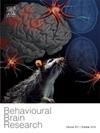(2R, 6R)-hydroxynorketamine ameliorates PTSD-like behaviors during the reconsolidation phase of fear memory in rats by modulating the VGF/BDNF/GluA1 signaling pathway in the hippocampus
IF 2.6
3区 心理学
Q2 BEHAVIORAL SCIENCES
引用次数: 0
Abstract
Rationale
Fear memory, a fundamental symptom of post-traumatic stress disorder (PTSD), is improved by (2R, 6R)-hydroxynorketamine ((2R, 6R)-HNK) administration. However, the phase of fear memory in which the injected drug is the most effective at mitigating PTSD-like effects remains unknown.
Objective
This study aimed to explore the effects of (2 R, 6 R)-HNK administration during three phases [acquisition (AP), reconsolidation (RP), and extinction (EP)] on PTSD-like behaviors in single prolonged stress (SPS) and contextual fear conditioning (CFC) rat models. The effects of VGF-inducible type of nerve growth factor (VGF), brain-derived neurotrophic factor (BDNF), and GluA1 on hippocampus (HIP) expression were also explored.
Methods
SPS and CFC (SPSC) were used to establish a PTSD rat model. After lateral ventricle injection of 5 μL (2 R, 6 R)-HNK (0.5 nmol). Anxiety-depression-like behaviors were assessed in rats by the open field test (OFT) and elevated plus maze test (EPMT). Situational fear responses were evaluated in rodents by freezing behavior test (FBT) test. In addition, GluA1, VGF, and BDNF were assessed in the hippocampus by Western blot assay (WB) and Immunohistochemistry assay (IF).
Results
SPSC procedure induced PTSD-like behaviors. The SPSC group had decreased spontaneous exploratory behavior and increased fear response. The (2R, 6R)-HNK group showed improved SPSC-induced reduction in GluA1, VGF, and BDNF levels in the HIP. During RP, anxiety and fear avoidance behaviors were alleviated, and the protein levels of GluA1, VGF, and BDNF in the HIP were restored. In contrast, no significant improvement was noted during AP and EP.
Conclusions
(2R,6R)-HNK modulates the VGF/BDNF/GluA1 signaling pathway in the hippocampus and improves PTSD-like behaviors during the reconsolidation phase of fear memory in rats, which may provide a new target for the clinical treatment and prevention of fear-related disorders such as PTSD.
(2R, 6R)-羟基炔诺酮胺通过调节海马中的VGF/BDNF/GluA1信号通路,改善大鼠在恐惧记忆再巩固阶段的创伤后应激障碍样行为
理由恐惧记忆是创伤后应激障碍(PTSD)的一个基本症状,服用(2R, 6R)-hydroxynorketamine((2R, 6R)-HNK)可改善恐惧记忆。本研究旨在探讨在单次延长应激(SPS)和情境恐惧条件反射(CFC)大鼠模型中,在获得(AP)、再巩固(RP)和消退(EP)三个阶段注射(2R, 6R)-HNK对创伤后应激障碍样行为的影响。研究还探讨了VGF诱导型神经生长因子(VGF)、脑源性神经营养因子(BDNF)和GluA1对海马(HIP)表达的影响。侧脑室注射 5 μL (2 R, 6 R)-HNK (0.5 nmol)后,大鼠出现焦虑抑郁样行为。通过开阔地试验(OFT)和高架加迷宫试验(EPMT)对大鼠的焦虑抑郁样行为进行评估。啮齿动物的情境恐惧反应是通过冻结行为试验(FBT)来评估的。此外,还通过 Western 印迹分析(WB)和免疫组化分析(IF)评估了海马中的 GluA1、VGF 和 BDNF。SPSC组的自发探索行为减少,恐惧反应增加。(2R,6R)-HNK组改善了SPSC诱导的HIP中GluA1、VGF和BDNF水平的降低。在 RP 期间,焦虑和恐惧回避行为得到缓解,HIP 中的 GluA1、VGF 和 BDNF 蛋白水平得到恢复。结论(2R,6R)-HNK能调节海马中的VGF/BDNF/GluA1信号通路,改善大鼠在恐惧记忆再巩固阶段的创伤后应激障碍样行为,这可能为临床治疗和预防创伤后应激障碍等恐惧相关疾病提供了新的靶点。
本文章由计算机程序翻译,如有差异,请以英文原文为准。
求助全文
约1分钟内获得全文
求助全文
来源期刊

Behavioural Brain Research
医学-行为科学
CiteScore
5.60
自引率
0.00%
发文量
383
审稿时长
61 days
期刊介绍:
Behavioural Brain Research is an international, interdisciplinary journal dedicated to the publication of articles in the field of behavioural neuroscience, broadly defined. Contributions from the entire range of disciplines that comprise the neurosciences, behavioural sciences or cognitive sciences are appropriate, as long as the goal is to delineate the neural mechanisms underlying behaviour. Thus, studies may range from neurophysiological, neuroanatomical, neurochemical or neuropharmacological analysis of brain-behaviour relations, including the use of molecular genetic or behavioural genetic approaches, to studies that involve the use of brain imaging techniques, to neuroethological studies. Reports of original research, of major methodological advances, or of novel conceptual approaches are all encouraged. The journal will also consider critical reviews on selected topics.
 求助内容:
求助内容: 应助结果提醒方式:
应助结果提醒方式:


